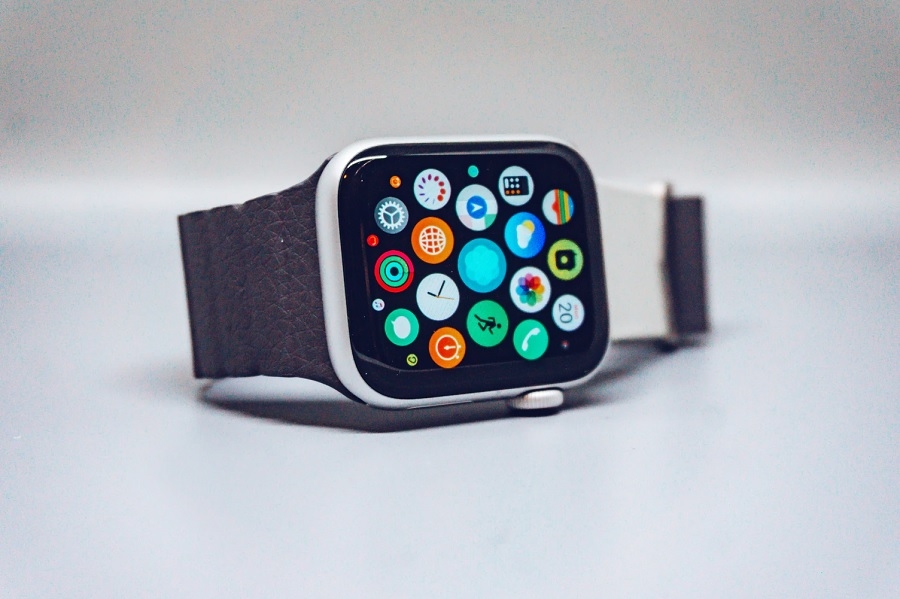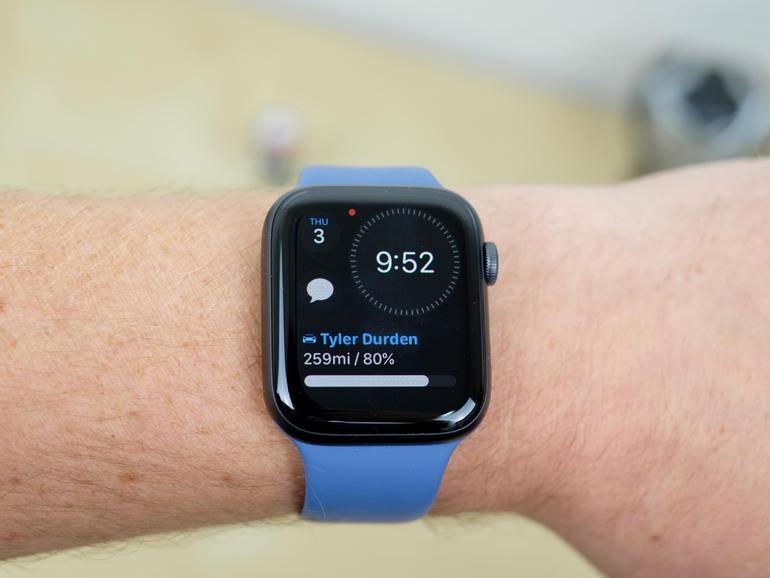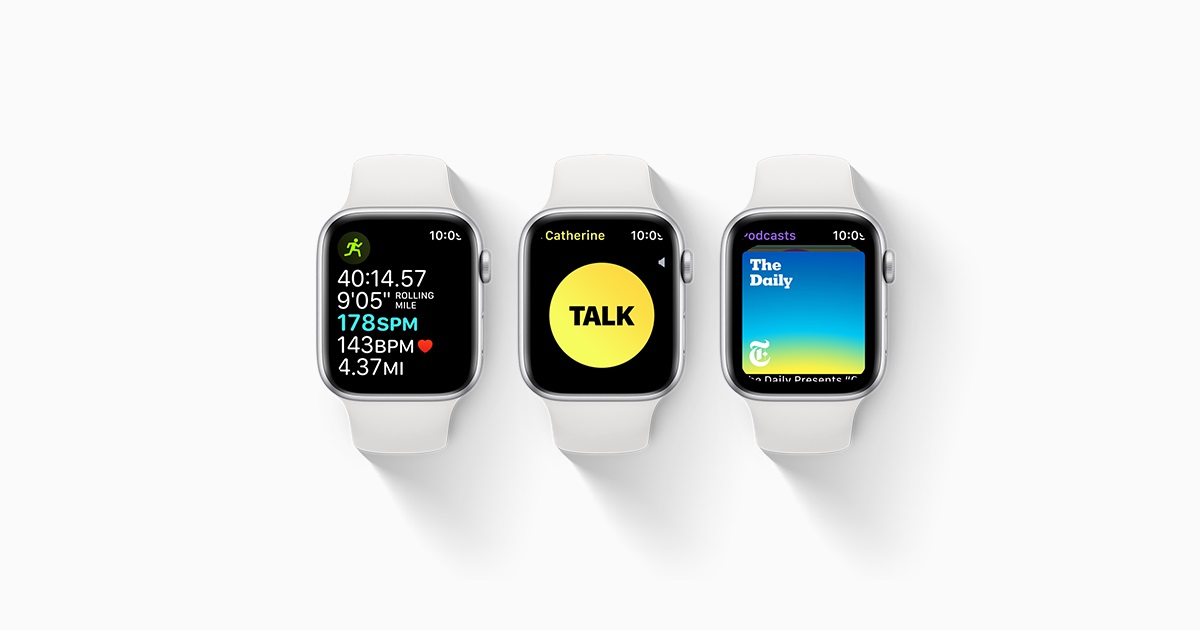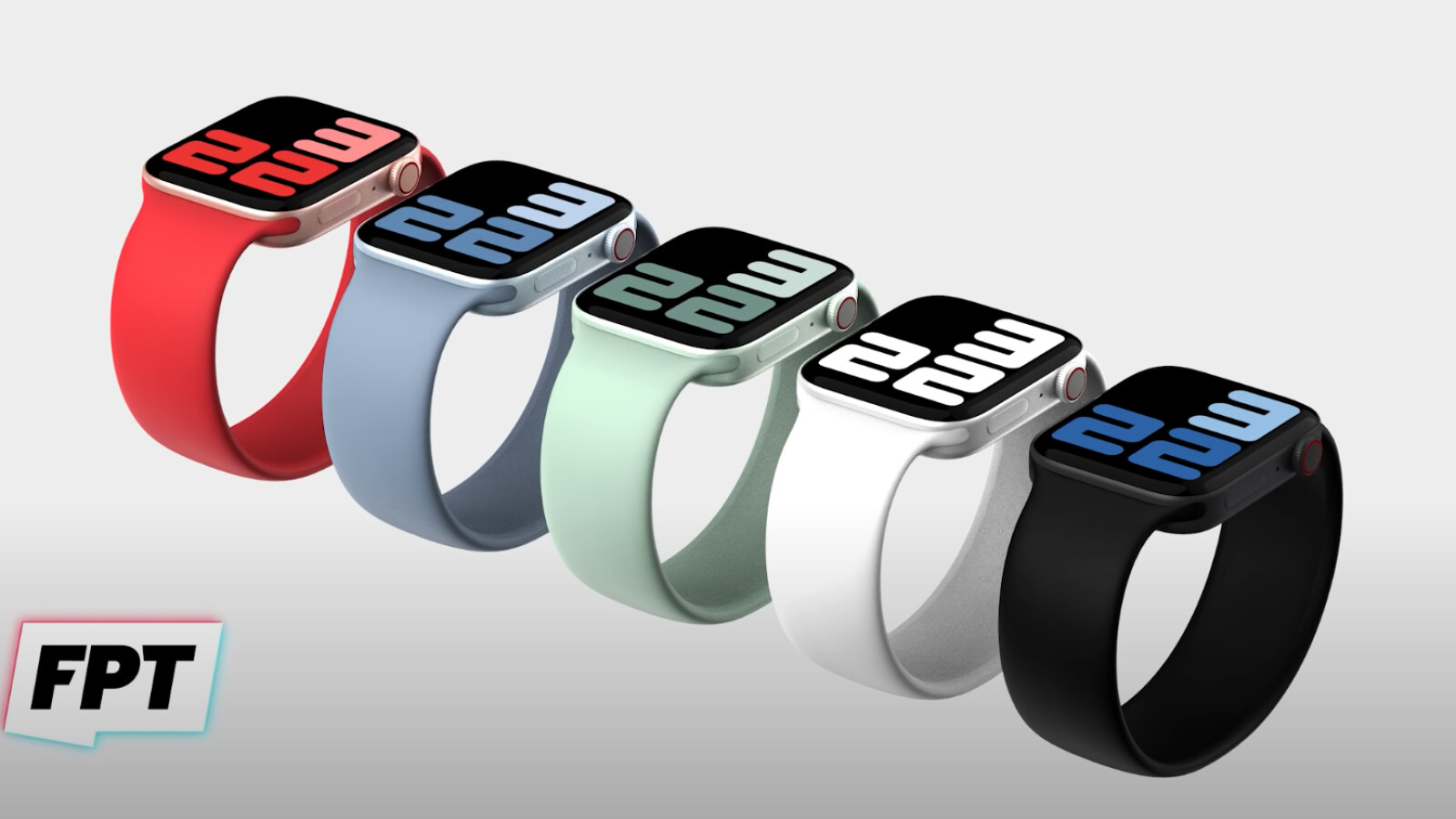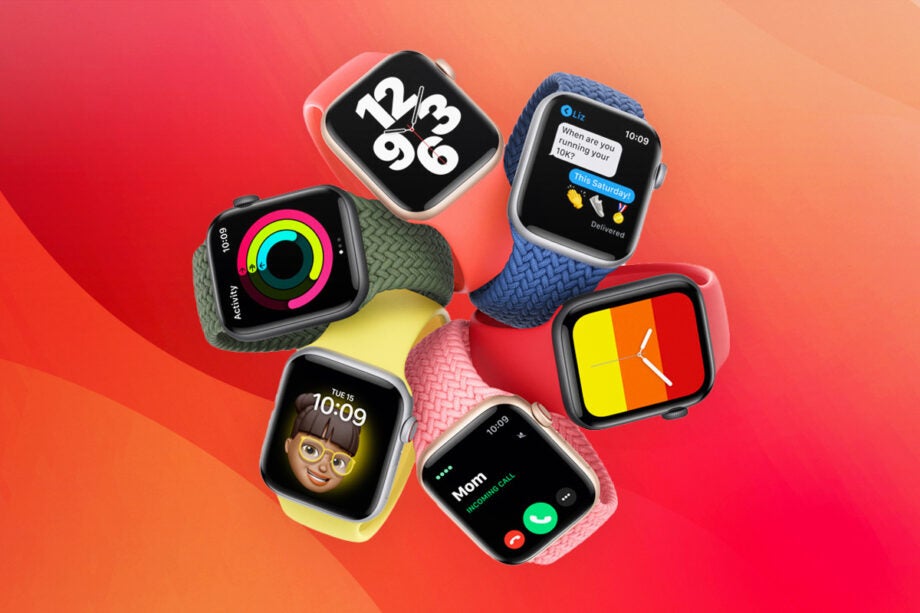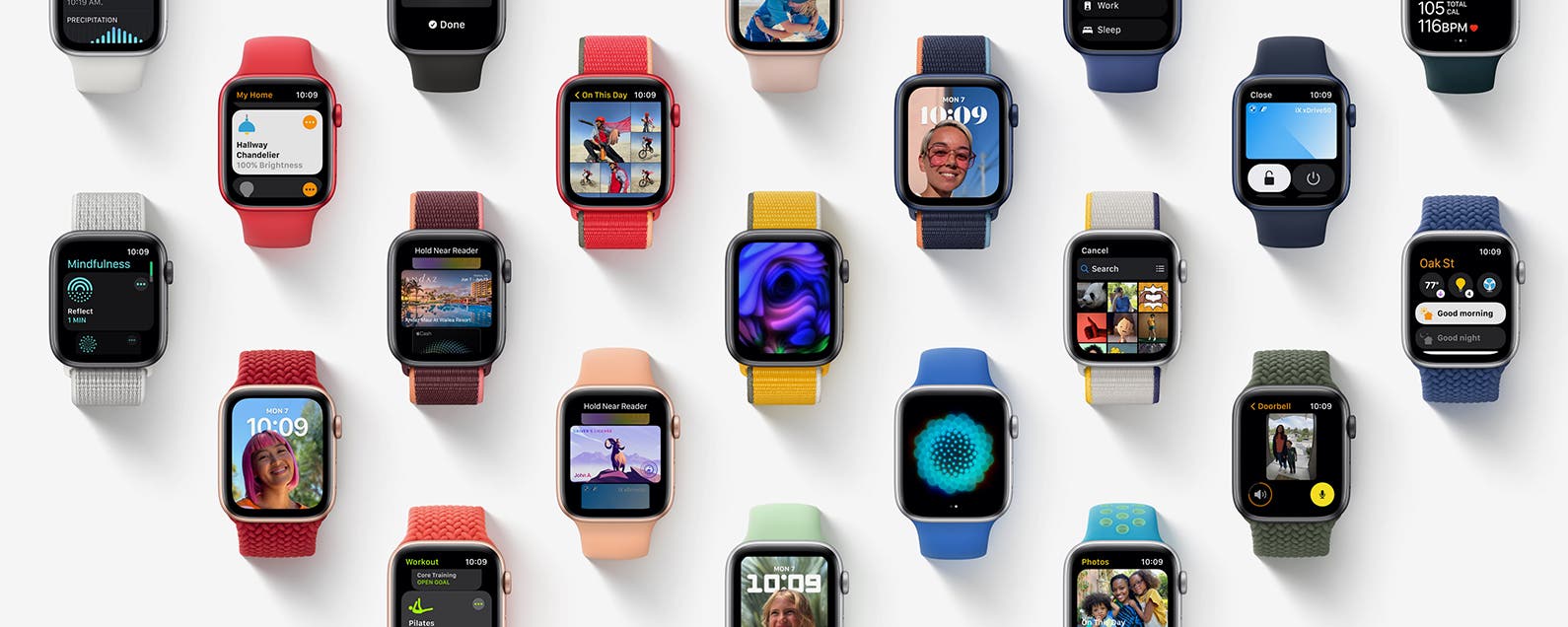The Apple Watch Series 7 offers the same suite of sensors as the Series 6. These include an accelerometer, a gyroscope, a heart rate sensor, a barometer, an always-on altimeter, a compass, an SpO2 sensor, and a VO2 max sensor. These sensors have a host of health and fitness tracking features, including blood oxygen monitoring, heart rate monitoring, sleep tracking, fall detection, workout tracking, and more.
Additional features include a new S6 processor that is up to 20% faster than the S4 and S5, a 2.5× brighter always-on display, and an always-on altimeter. The Series 6 watch was updated with faster charging hardware such that it completes charging in ~1.5 hours. Force Touch hardware was removed, consistent with the removal of all Force Touch functionality from watchOS 7. This new Apple Watch also shares the same sensor as last year's, so you'll have to wait for the hotly anticipated blood pressure and glucometers features in Apple Watch Series 8 .
However, you can still track your blood oxygen levels, ECG and heart rate, so it's still a solid smartwatch for fitness buffs. There's also a new mindfulness app, cycling fall detection and calorie burning calculator, which overall makes this the best Apple Watch to date. Apple's latest smartwatch is mostly an incremental upgrade from the Apple Watch 6, maintaining an 18-hour battery life, the same CPU and adding no new health features. But the enlarged display is game-changer, and makes it difficult to return to previous-generation models. The Series 7's big screen adapts wearable computing for more everyday applications, making it practical to be productive from your wrist.
At just 1.7 mm thin, the narrower borders of Apple Watch Series 7 maximize the screen area of the display while minimally changing the dimensions of the watch itself. Apple Watch Series 7 also features a user interface optimized for the larger display, a new QWERTY keyboard, plus two unique watch faces — Contour and Modular Duo — designed specifically for the new device. Users benefit from the same all-day 18-hour battery life,1 now complemented by 33 percent faster charging. Apple hasn't explicitly mentioned the battery capacity of the Watch Series 7, but it should last an entire day on a single charge. However, compared the previous generation smartwatch model, the Watch Series 7 charges 33% faster. Apple has updated the charging architecture and used a Magnetic Fast Charger with a USB-C cable for the Watch Series 7.
The watch's battery level can go from 0-80% in around 45 minutes. If you charge the Watch Series 7 for up to 8 minutes, you can easily get 8 hours of sleep tracking. The Series 7 is also equipped with new hardware that enables ultra-rapid, short-range wireless data transfer at 60.5 GHz, though Apple has not fully explained this new functionality. The Apple Watch has increasingly become a health and fitness-focused smartwatch. The latest Series 6 has incredibly useful features that assist in improved health.
These features include ECG monitoring, blood oxygen sensor, irregular heart rhythm notifications, and high and low heart rate notifications in addition to other things. We expect the upcoming Apple Watch Series 7 to introduce blood sugar monitoring. As for the sensors, the Watch Series 7 has the same sensor as that of the Apple Watch Series 6. It includes an accelerometer, barometer, ECG , gyroscope, heart rate sensor, SpO2 sensor, and a VO2 Max sensor. Equipped with all these sensors, the Watch Series 7 offers blood oxygen monitoring, fall detection, heart rate monitoring, sleep tracking, and much more.
Note that the altimeter can be inaccurate in some weather conditions. The Apple Watch Series 7 offers the same health monitoring features available with the Series 6. A built-in accelerometer and gyroscope enable other important health-related features such as fall detection. The Apple Watch Series 7, announced in September 2021, is the current iteration of the Apple Watch that originally launched in 2015 and replaced the Series 6. The Apple Watch Series 7 builds on the design of previous Apple Watch models with a more rounded design and offers some notable new features including larger displays, improved durability, and faster charging.
There are some tradeoffs with the Apple Watch Series 3 because it is a much older model, such as a smaller display, an older chipset, and the lack of a compass, fall detection, ECG, and blood oxygen monitoring. On the fitness front, WatchOS 8 features enhanced support for biking. The watch will now be able to detect when you start riding a bike and prompt you to start a cycling workout.
Biking workouts now also support auto-pause/resume, as well as fall detection. With an increased affinity for tracking users on a bike, Apple claims that mid-ride GPS and heart rate detection will improve. So, it's only fair to expect a lot more from the rumoured Apple Watch Series 8, which is expected to launch in September 2022.
Some are hoping for glucose, alcohol, and blood pressure sensors – not to mention, a processor faster than the S7, which is just a more power-efficient S6 chip to support that bigger display without sacrificing battery life. However, hopes seem dashed on the former as Bloomberg Apple expert Mark Gurman has predicted otherwise. In the past, Apple's watchOS looked similar across all its smartwatches, minus select apps exclusive to the new hardware inside a given model. Apple Watch 7 doesn't have new sensors, though, so instead the company altered watchOS 8 for a bigger screen.
Initial reviews for the device have been generally positive with some caveats. Reviewers praised the watch's potential ability to integrate into everyday life and the overall design of the product, but noted issues of speed and price. Many reviewers described the watch as functional and convenient, while also noting failure to offer as much potential functionality as preceding smartphones. Farhad Manjoo of The New York Times mentioned the device's steep learning curve, stating it took him "three long, often confusing and frustrating days" to become accustomed to watchOS 1, but loved it thereafter.
Some reviewers also compared it to competing products, such as Android Wear devices, and claimed "The Smartwatch Finally Makes Sense". He concluded that there is no "killer application" so far besides telling the time, which is the basic function of a wristwatch anyhow. TechRadar gave it a score of 4.5/5, calling it one of the top smartwatches, while criticizing the short battery life. Digital Trends gave it a score of 5/5, calling it Apple's best product and praising the design, build quality, and software, among others, while criticizing the battery life.
CNET gave it a score of 8.2/10, calling it the "best overall smartwatch around", while criticizing the battery life and lack of watch face options. T3 gave it a score of 5/5, calling it a "truly next-gen smartwatch" due to its thinner body and bigger screen compared to the Series 3, and health features. Apple Watch Series 4, which launched a year later, featured a major redesign with a screen that was 30% bigger in both models and a 50% improvement on its processor over the Series 3 version. Speakers and microphones were rearranged so they were louder and more useful, and Series 4 introduced the fall detection feature, ECG capabilities, and the second-generation heart rate monitor. Apple is enthusiastic about physical health and mental health, the company has been adding these features to each new device.
To counter this, Apple has now characterized this feature as a "wellness feature" and not an accurate medical function. These new features depict an increasing trend towards health considerations that are supremely important in this day and age. There is also a possibility that by the time Apple officially launches the new lineup, the FDA would have approved the feature.
Leaks concerning the design of the Apple Watch Series 7 have shown it in a range of colors, including green, and it is also expected that the next-generation smartwatch will have slimmer bezels and a thicker case. Unsurprisingly, a faster SoC should be involved, with the potentially named Apple S7 chip outpacing the older Apple S6 (for reference, the S6 was up to 20% quicker than the S5). As for features, fans should look forward to typical smartwatch health utilities such as blood oxygen measurement and 24/7 heart-rate tracking.
As before, the Apple Watch Series 7 comes with a plethora of health features, including an ECG app to measure ECG, Blood Oxygen measurement support, and heart rate notifications. In addition, the company says that the Apple Watch Series 7 is the first smartwatch from the company to get an IP6X certification for dust resistance and a WR50 certification for water resistance. Apple has also made some significant improvements to battery life and charging on the Apple Watch Series 7. The company claims that the new smartwatches offer 18-hour all-day battery life, along with 33% faster charging than the previous model. This might sound negligible over previous years, but again, switching from the Series 3, there is definitely a noticeable weight difference to the new watch.
Couple that with the larger size means the new form factor has taken a little bit of adjustment, and if a lightweight, low-profile watch is important to you for exercising, this is just something to bear in mind. On the whole, however, what Apple has done in packing this larger, more vibrant display, better battery life, and SiP improvements into a Watch that barely any bigger than the previous model is definitely to be lauded. A series of seemingly negligible design changes actually add up to make a big difference, and whilst at first glance the Series 7 doesn't look much different, it feels almost like a whole new product.
Paradoxically, one of the best things about the Series 7 is that despite all the new screen real estate, it feels like the design, relatively speaking, has barely changed at all. WatchOS 8 comes with additional watch faces specifically designed to fit the Apple Watch Series 7 bigger display. And of course, what is an Apple Watch without its health and wellness features? The watch comes with a new Mindfulness app, and with the important for your health monitoring sleep respiratory rate tracking. In terms of workouts, some new workout types such as Tai Chi and Pilates are also added. Interestingly, the Apple Watch Series 7 can charge faster than any other model.
Another new, great, feature is the ability to charge the watch for only 8 minutes to get 8 hours of sleep tracking. The battery life, however, is the same as its predecessor, around 18 hours of life between charges, which is an impressive feat with the Always-On display. The new generation Apple Watch brings minor changes compared to Watch Series 6 in terms of features and specifications.
However, it has a new design that includes even thinner bezels and a bigger screen with curved edges on all sides. The Apple Watch Series 7 replaces the Series 6 in Apple's roster, but it isn't a massive upgrade in terms of its abilities. The Series 7 is mostly a slight design refresh with a larger screen and thinner bezels. Otherwise, the Series 7 has the same health and fitness sensors as the Series 6 — it's essentially the Series 6 with a slightly better design. Fortunately, Apple prices the Series 7 equally to the Series 6's $400 launch price, and the company isn't charging a premium for a mere design refresh. A lot of the Apple Watch Series 7's biggest improvements revolve around its new, larger watchface display—available in 41mm and 45mm sizes, versus the Apple Watch Series 6's 40 and 44mm options.
That doesn't sound like much, but Apple claims the watchface features "nearly 20-percent" more screen thanks to thinner, 1.7mm borders. To take advantage of the bigger screen, WatchOS 8 will add two new watch faces designed specifically for Apple Watch Series 7. The new operating system adds new UI upgrades for the bigger screen, such as larger font sizes. Apple announced the newest version of the Apple Watch at its September 2021 "California Streaming" keynote event. The Apple Watch Series 7 is a substantial upgrade over last year's Apple Watch 6, adding a larger, redesigned screen, more durable construction, new colors, apps, and other tweaks.
Apple also announced the release date for the next version of the Apple Watch operating system, WatchOS 8, and new features for Apple Fitness+. With the new model just around the corner, let's take a look at what's new and exciting about the Apple Watch Series 7. If like me you don't wear your Watch whilst sleeping, you should find yourself charging your Watch every 1.5 days, as opposed to every day on older models.
If you're a Series 6 owner, you'll be upgrading for faster charging, but not longer life. Make no mistake though, the upgrade to charging is a big one and makes the Apple Watch a much more reliable companion if sleep tracking is important to you. And like I said, given the improvements to the Watch's display, the fact the battery life hasn't diminished I think is an accomplishment in and of itself. Apple says that with the introduction of sleep tracking on Apple Watch, it has noticed a shift in the way users use, and charge, their devices. To this end, you can charge your Series 7 for just eight minutes to enable a full 8-hours of sleep tracking, and zero to 80% takes just 45 minutes. The key to this is the improved battery connector on the back of the watch and corresponding changes in the new charge cable's puck.
This means that you'll only get the full fast-charging experience if you use the charger that came in the box with your new Watch. If you use a third-party stand or any other charger from Apple, you'll get the regular charging speed from last year. WatchOS 4.0 was announced at WWDC 2017 and released to the public in September 2017. WatchOS 4 features a proactive Siri watch face, personalized activity coaching, and an entirely redesigned music app.
It also introduces Apple GymKit, a technology platform to connect workouts with cardio equipment. In comparison to other Apple products and competing smartwatches, marketing of the Apple Watch promoted the device as a fashion accessory. Apple later focused on its health and fitness-oriented features, in an effort to compete with dedicated activity trackers. The watchOS 3 added fitness tracking for wheelchair users, social sharing in the Activity app, and a Breathe app to facilitate mindfulness.
Beyond this, the Apple Watch Series 7 will have many of the same health and fitness features we are used to seeing in Apple's smartwatches. This includes the infamous activity rings, sleep tracking and various ways to track your workouts. This watch face will show 24 time zones simultaneously on the display. Reportedly, Apple is working on some others watch faces that will be exclusively available in Series 7. The new smartwatch will have an S7 cheap that will provide a better battery life. And according to Ming-Chi Kuo, many health sensors will be missing in the latest release.
In fact, they have a plan to re-introduce them in the 2022 Apple Watch series. After months of leaks and rumors , the Apple Watch Series 7 is finally here. The new smartwatches come with several big upgrades over the previous models, including bigger displays, updated hardware, and more. If you're thinking of getting one for yourself, you've come to the right place. In this post, we'll take an in-depth look at the brand-new Apple Watch Series 7 and tell you everything you need to know to make an informed purchase.
The GPS and cellular model of the Apple watch SE allows you to text, call, get directions and stream music all without your phone, making it a great choice for those who prefer to work out with empty pockets. WatchOS 3.0 was announced at WWDC 2016, with a priority on performance. Users are able to keep apps running in memory as well as receive background updates and refreshed information. Other updates include a new Dock invoked with the side button to replace the performance-laden Glances, an updated Control Center, and new reply options on Messages. Several new watch faces have also been added, including Minnie Mouse, along with the ability to switch watch faces from the lock screen simply by swiping. A new app called Breathe guides users through breathing exercises throughout the day, with visuals and haptic feedback.
For input, the Watch features a "digital crown" on one side which can be turned to scroll or zoom content on screen, and pressed to return to the home screen. Next to the crown is the Side Button, which can be used to display recently used apps and access Apple Pay, which is used for contactless payment. Force Touch has since been physically removed in Watch Series 6 and Watch SE, and has been disabled via software on Watch Series 5 and earlier on models supporting watchOS 5. As an ultra low-cost option, Apple is continuing to sell the Apple Watch Series 3, priced starting at $199. The Series 3 has an older design with a smaller display, a much slower S3 chip, and no blood oxygen sensor or ECG function. It is GPS only and lacks a few other bells and whistles like always-on altimeter and compass that are found in the other Apple Watch models.
The Series 3 is several years old at this point and is using outdated technology, so we do not recommend purchasing it. The Apple Watch can now charge 33 percent faster charging compared with Apple Watch Series 6 thanks to a new charging architecture and Apple's Magnetic Fast Charger USB-C Cable and an 18W or higher power adapter. This means that just eight minutes of charging time can provide up to eight hours of sleep tracking. The Magnetic Fast Charger USB-C Cable ships with the Apple Watch Series 7, but users will need to supply a 20W or higher power adapter to get fast charging.
